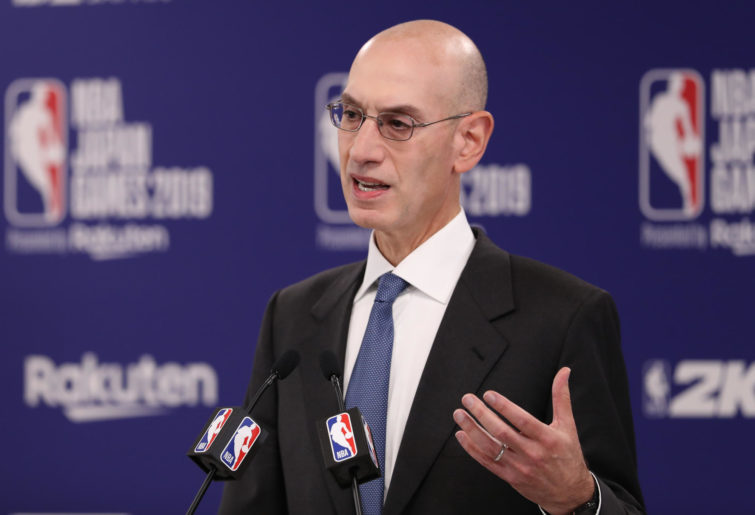We are two months into the NBA hiatus and still have no clear indication when basketball will resume.
This situation is far from ideal. However, the break does give the league a chance to reflect on the game, think about the future and brainstorm some innovative ideas.
Expansion is an idea that is never far from the minds in the league’s office. Expansion is no small task. While there has been enthusiasm for the concept, global exploration, and markets crying out for a chance or a second chance (namely Seattle), there is still no clarity on what expansion might look like.
In all likelihood, COVID-19 will send expansion to the very end of the list of priorities as the NBA seeks to stabilise and recover from the significant disruption.
However, exploring the idea is a fun exercise nonetheless. So here is a bold plan for expansion. It is potentially too bold, but if the NBA is facing something of a reset or reboot, maybe now is the time to be bold.
Commissioner Adam Silver has plainly indicated global expansion is the NBA’s preference.

(Takashi Aoyama/Getty Images)
As far as the dollars go, global expansion offers the best return on investment for the NBA. The NBA has recently established itself in Mexico and Europe, so these regions are the prime candidates for expansion.
Seattle has been calling out for the return of the NBA for well over a decade now, Las Vegas is quickly becoming a sports town and basketball is booming in Canada, making Vancouver a viable option. But these cities will have to wait while the NBA conquers the world.
This expansion will see six new teams joining the NBA: five in Europe and one in Mexico.
The NBA would place a team in each of London, Paris, Barcelona, Madrid and Rome. The NBA has played eight regular-season games in London since 2011 and in 2020 it took the game to Paris.
These are large markets that can support NBA teams. The global games provide a proof of concept and a logistical test case for London and Paris, and Italy and Spain are international basketball outposts.
Like London, the NBA has extensive experience in Mexico City, which has hosted ten regular-season games since 2015, and its proximity and cultural ties make Mexico a natural choice for global expansion.
First and foremost the NBA does away with divisions. This has been a long time coming and as we will see shortly, the new NBA does not need divisions for logistical purposes in my model. The five European teams are added to the Eastern Conference and the Mexico City team will be added to the Western Conference.
Then two current Eastern Conference teams will be moved to the Western Conference, most likely Milwaukee and Chicago, as the two westernmost franchises in the east (both are closer to Minnesota than almost any other Eastern Conference team).

(AP Photo/Brandon Dill)
This brings the league to 36 teams, with 18 in each conference. The beauty of this structure is that if each team plays every other team twice, once home and away, each team plays 70 games. All of a sudden the NBA has its shortened schedule without actually losing the total number of games. In fact, the NBA gains 30 games.
As it stands there are 1230 regular season games per season. In this form there would be 1260, but each team and player would play 12 fewer games. This is a huge advantage for this expansion model, killing two birds with one stone: player load and global expansion.
Obviously the biggest challenge is travel, however this can be easily overcome in this model. Placing multiple new teams in a small geographic region (a region significantly smaller than the Northwest division) actually makes it easier.
While it is a reasonably long journey over, the trip from the East Coast to Europe is not significantly longer than the flight from New York to Los Angeles. Adding five European teams, all within a two-hour flight of one another and in just two time zones, allows for teams to undertake European tours and play all five of their overseas European games in one ten-to-15-day trip.
Yes, West Coast teams would likely have to add East Coast games on both ends of their European tour to make it work but this is not an insurmountable issue.
As it is not reasonable for US-based teams to travel to Europe more than once it would necessitate that all European teams remain in Europe at the same time, and consequently would do their US tours at the same time. This would likely break their season into home-and-away segments.
Each team would have 31 away games to play in the US and Mexico. Teams could take two tours, one on each coast: 13 games in the east and 18 in the west. That could be done over the course of four and six weeks each.

(Jayne Kamin-Oncea/Getty Images)
If travel is an issue, the NBA could even get creative and only have half the US teams tour each year and play an away-and-away series against each team, with the other teams staying in the US and having a home-and-home series with the European teams. This would reduce travel by half. US-based teams touring at the same time could even participate in global games in other European cities if the NBA wished to continue expanding its influence.
A major advantage of this proposal is the time zones. London is five hours ahead of the East Coast. Paris, Rome, Barcelona and Madrid are six hours ahead. Presently NBA games air in Europe primarily between midnight and 5am, making live viewing in Europe virtually impossible.
Adding five European teams will add a prime-time product to a large European market. The African and Middle Eastern markets will also benefit as they share similar time zones with Europe. Games played in prime time in Europe will air at lunchtime on the East Coast and the morning on the West Coast.
Presently the majority of East Coast NFL games air in the mornings in the West Coast, and you only have to ask Australians and Kiwis what it’s like to have games on during work hours. You may not get down to the pub to watch but lunch breaks are great and fantasy stat-trackers are never closed. And lunch games make for excellent weekend viewing.
Superficially this might seem like an impossible undertaking for the NBA but the opportunity and upside is huge. But it really only functions with an all-in approach like the one outlined here. The economies of scale that result from implanting a whole division in Europe is when the benefits begin to outweigh the costs. Adding one team in London is a lot of travel for one game. It is a lot of energy for a significantly smaller TV product.
Are there risks? Absolutely. How will teams in Madrid, Barcelona and Rome function alongside the local league and EuroLeague?
Playoff travel would also present some challenges. While it is not uncommon for teams to travel two or three hours for a series in the first three rounds, a five-hour or six-hour journey is more challenging. Moreover, a home-and-away series in its current format between the Lakers, for example, and a European-based team would require at least two 12-hour flights, and is likely untenable. Although this could be solved with a neutral-site finals, not dissimilar to the Super Bowl or NCAA Final Four.
It might seem absurd, and it almost certainly is. It is impossible to see the NBA expanding by six teams at once, let alone with five teams in Europe. But if the NBA were serious about establishing a foothold in Europe, doing so with multiple teams may reduce some the logistical issues. Not to mention such a model sees revenue stay up, while games go down. It also provides prime-time access to a much larger audience in Europe, Africa and the Middle East, without being unwatchable in the domestic market.































































































